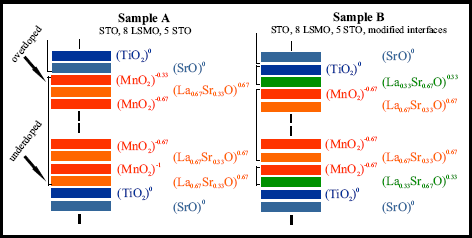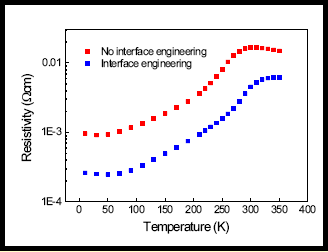After the remarkable discovery of the difference in conductivity of TiO2 and SrO terminated SrTiO3-LaAlO3 interfaces, much attention has been focused on the polar discontinuity driven electronic reconstruction. Similar reconstructions can be expected at other transition metal oxide interfaces as well.
We study the interface between the half metal La0.67Sr0.33MnO3 (LSMO) and band insulator SrTiO3 (STO), which is important for tunnel magnetoresistance devices. In the ionic limit a polar discontinuity arises at the interface and a reconstruction must occur.
Here we show that the reconstruction can be avoided with the use of interface engineering. By inserting a monolayer (La0.33Sr0.67O) with intermediate net charge the potential build-up is suppressed.
The interface engineered samples have improved magnetization and conductivity for very thin layers, indicating improved properties at the interface.
Samples

Assuming all reconstructions are electronic and stability of the Mn4+ valence state, the polar discontinuity at the LSMO/STO interface results in an overdoped and an underdoped interface. For the interface engineered samples all Mn layers are optimally doped.
Results

A significant increase in conductivity is observed after applying the interface engineering for these 8 unit cell layer LSMO samples. The Curie temperature and the saturation magnetization are increased as well. Similar results have been obtained for a range of samples with different thicknesses.
This project is performed by: Hans Boschker
Daily supervisor: Guus Rijnders
